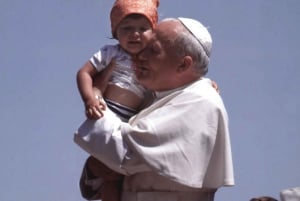
From Krakow: In the Footsteps of John Paul II
12 ReviewsThe tour gives you a chance to follow in the footsteps of the man who was to become one of the greatest Popes and human beings in history.
Late Pope, Karol Wojtyla, pre-Vatican life in Krakow.
It is perhaps difficult for a foreigner to understand the depth of Poland's attachment to the late Pope, John Paul II. To many, his life and work demonstrated an incredible love for mankind and hope for the future, and for the Poles under communism, this sense of hope was particularly strong. In a country whose culture is so intricately connected to religion and especially to Catholicism, at a time when religious practice was heavily oppressed, John Paul II represented not only the Poles' identity as a people, but also their inspiration to keep believing in the ultimate victory of their history, culture and national unity. It was his famous speech in Warsaw in 1979 that marked a spiritual turning point in the Poles' struggle for freedom, and he remained a constant and powerful leader throughout the solidarity movement.
John Paul II, born Karol Wojtyla in 1920, grew up in Wadowice, a small town not far to the south-west of Kraków; his family home has been turned into a museum. He studied at the Jagiellonian University in Kraków until it was closed under the Nazi occupation. During the war years, he worked as a manual labourer in the limestone quarry in the Zakrzówek district, and in the Solvay factory in south-west Kraków; it was at this time that he began studying for the priesthood at an underground seminary.
In 1958, Karol Wojtyla took up his appointment as Bishop of Kraków at the Bishops' Palace on Franciszkanska street, just opposite the Franciscan church and standing alongside the Planty gardens. He would greet his loving crowds from the window above the entrance gate. Every year on the anniversary of his death, a sea of candles is lit across the churchyard lawn and a remembrance ceremony held at this spot. During these years he lived in the 'Dean' House, at 21 Kanonicza street, now a museum exhibiting souvenirs of his life.
For those interested in the struggles of the church under communism, it is certainly worth visiting Arka Pana (Ark of the Lord) Church in Nowa Huta. During these years of religious oppression, in what was to be a model neighbourhood free of spiritual influence, Bishop Karol Wojtyla's celebration of mass at this spot before construction, laying of the foundation stone and consecration of the church were particularly significant.
Another significant place for the late Pope was the Sanctuary of Divine Mercy in Lagiewniki. His first connections with the sanctuary reach back to his days in the nearby Solvay Soda Works during the war; its message of divine mercy was particularly important to him. The new Basilica at the sanctuary was consecrated by Pope John Paul II in 2002.
It's not difficult to find traces of Karol Wojtyla's influence in Kraków - schools, streets and even the Kraków-Balice airport have been named after him. There are several monuments to him throughout the city, including a grand statue across from Wawel Cathedral, a bust in the sculpted flower gardens of Jordan Park, and the Papal Stone, a 26-tonne chunk of granite taken from Morskie Oko in the Tatra Mountains and placed on the Blonia, the wide green field that stretches between the Old Town and the wooded hills of the Zwierzyniec district, which was packed solid with devoted followers during the pope's visits to the city of his youth.
My Guide Krakow is part of the global My Guide Network of Online & Mobile travel guides.
We are now in 120+ Destinations and Growing. If you are interested in becoming a local travel partner and would like to find out more then click for more info about our Website Business Opportunity.
Filter Events by Sub-Category
Please select a Date first.